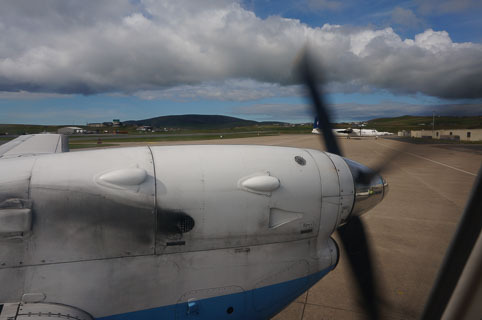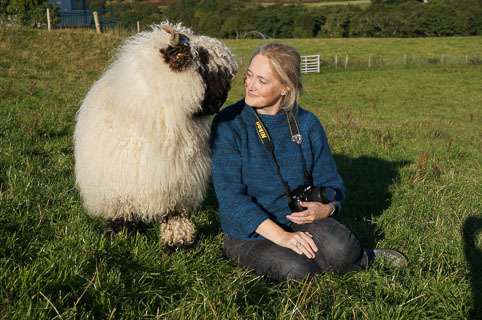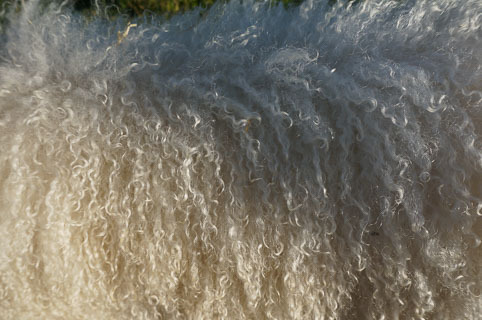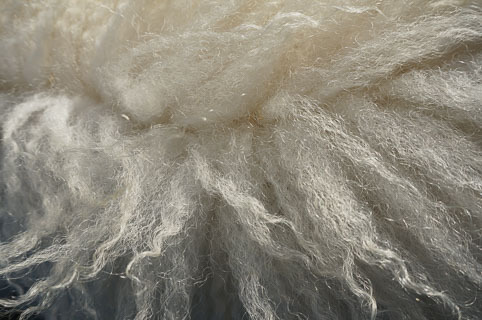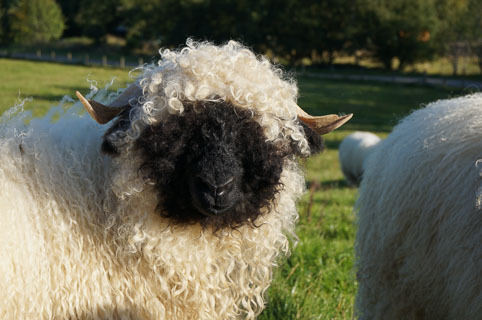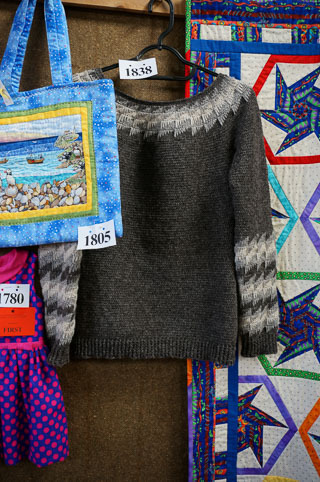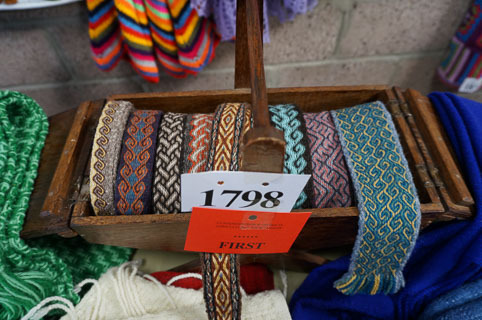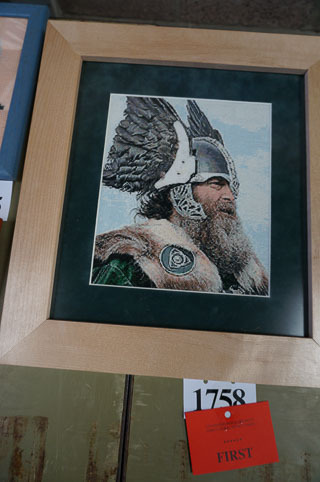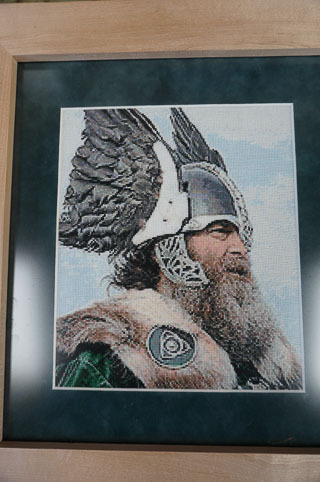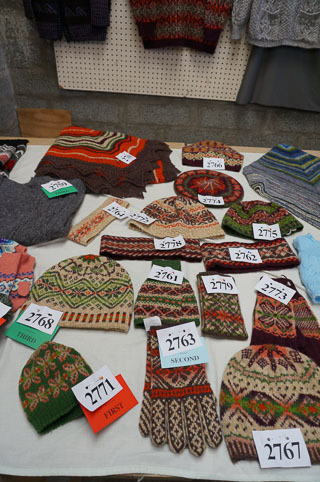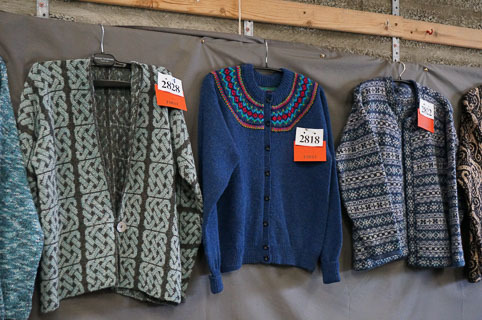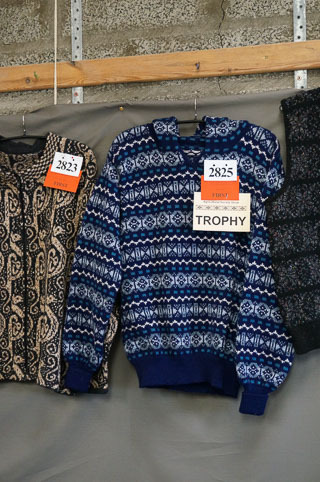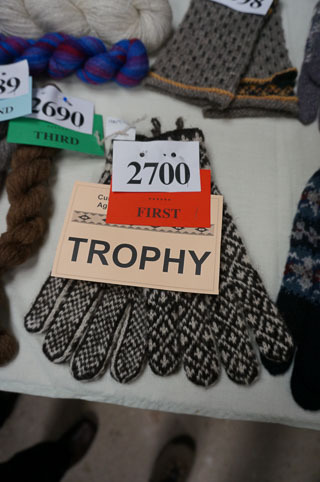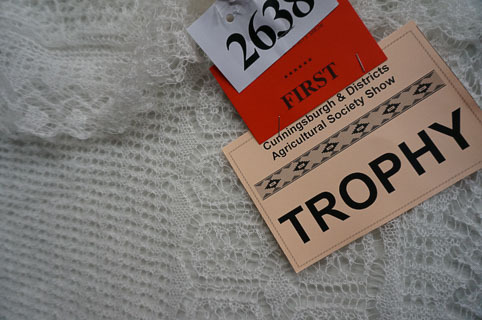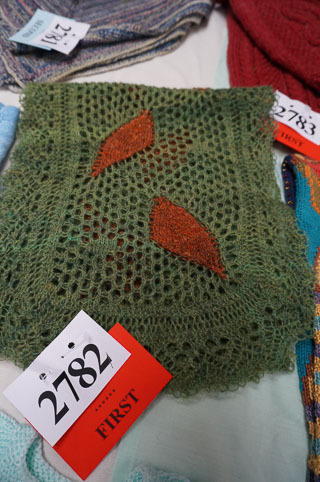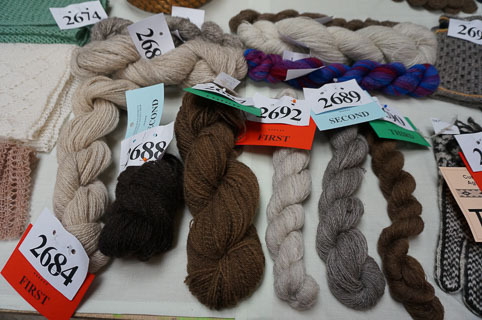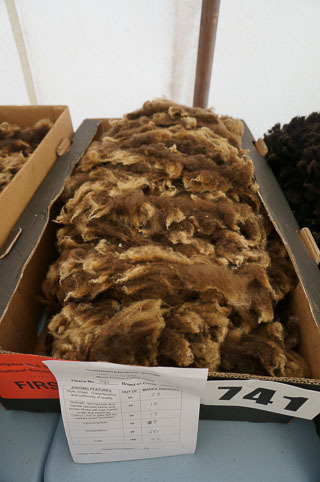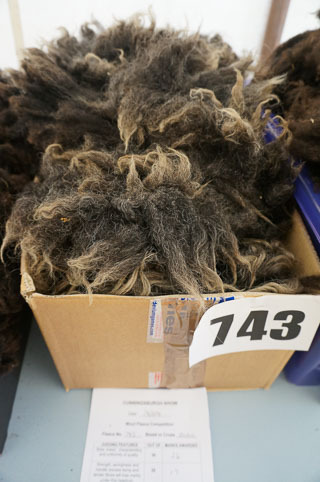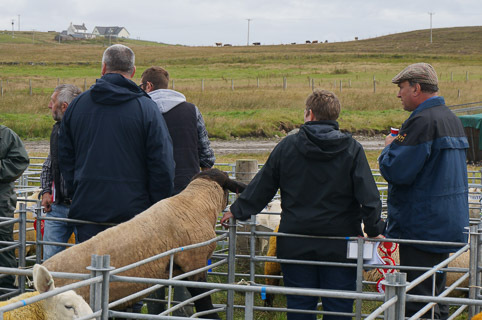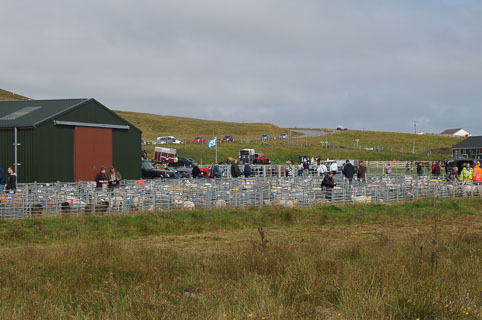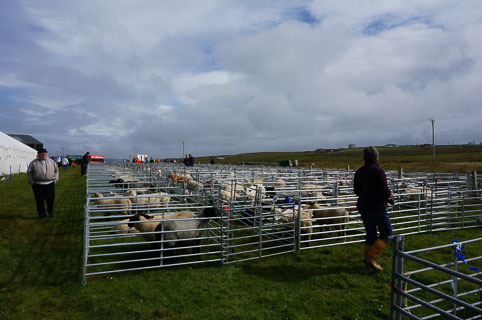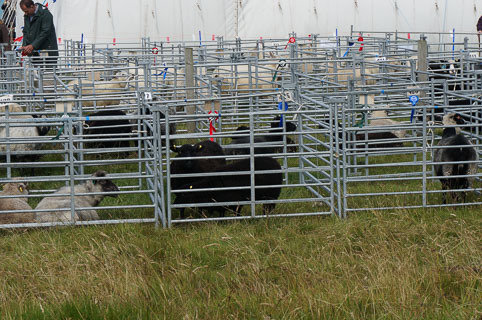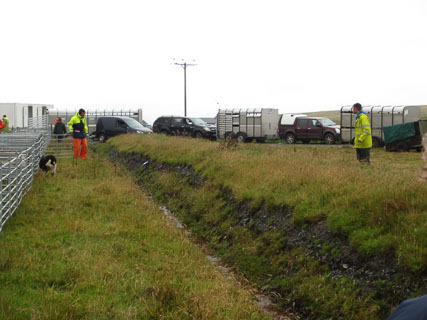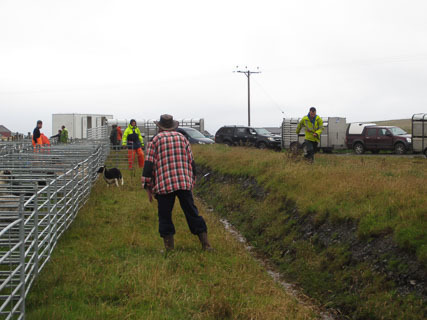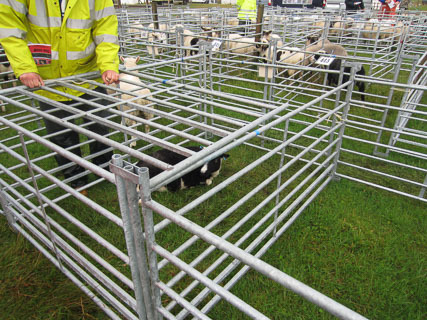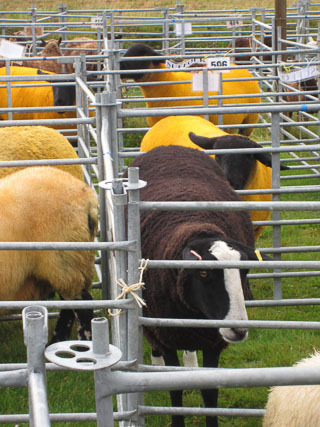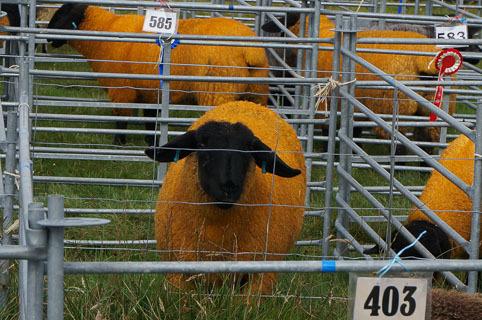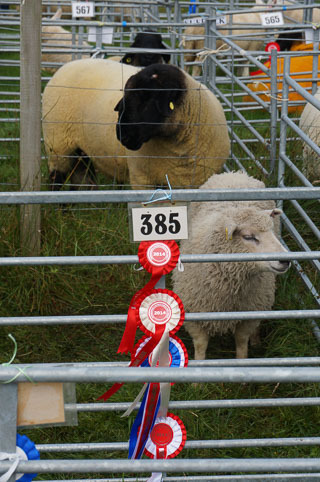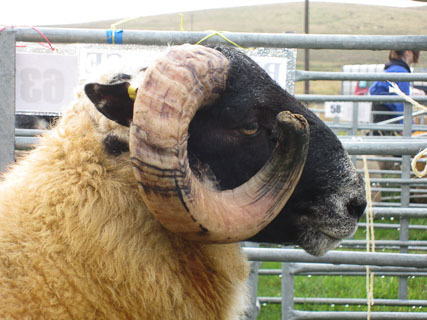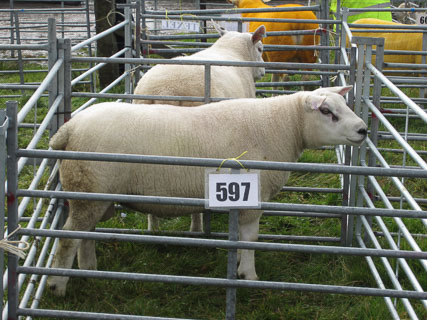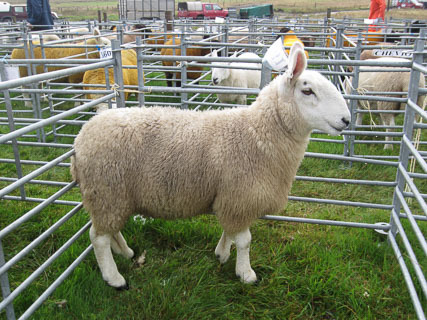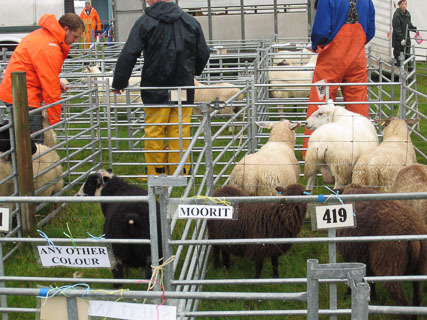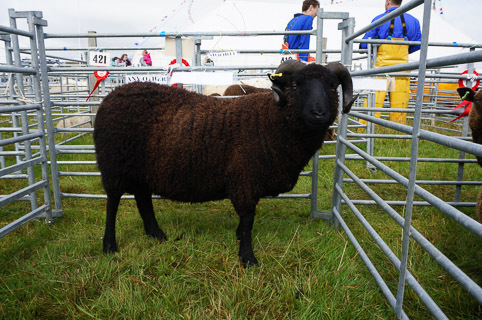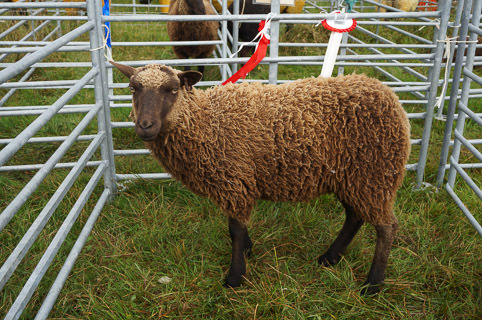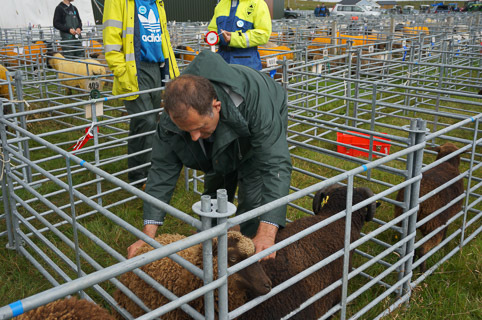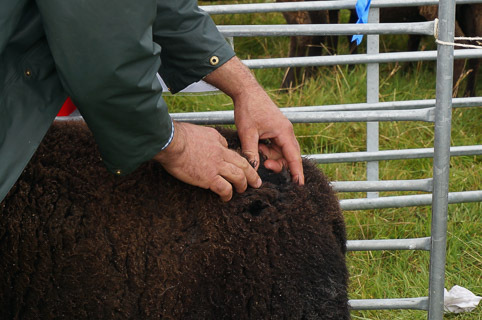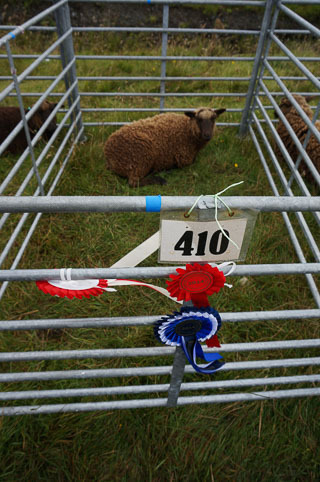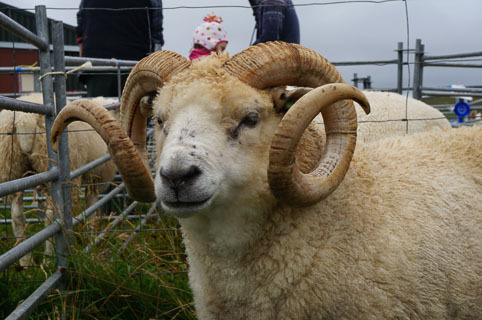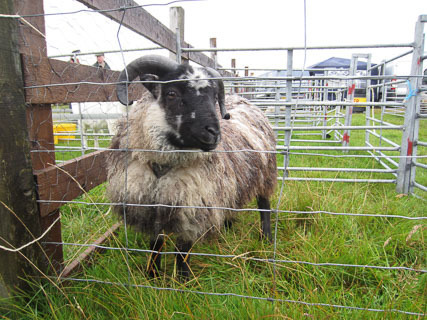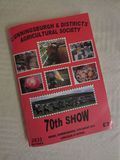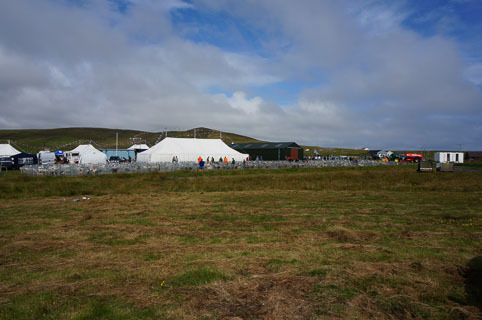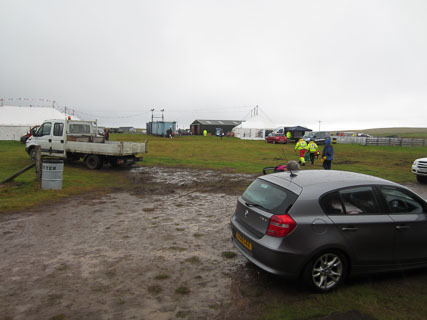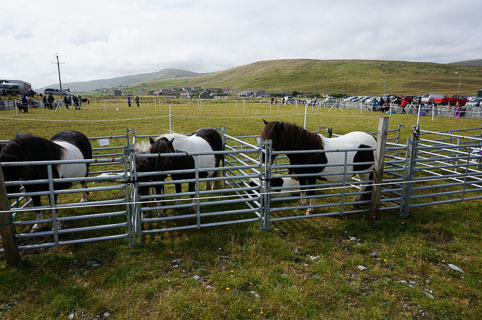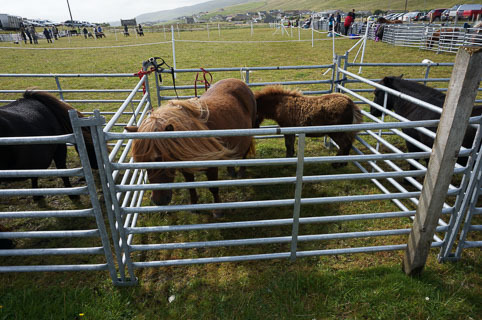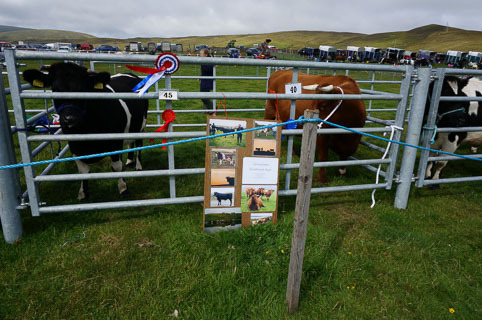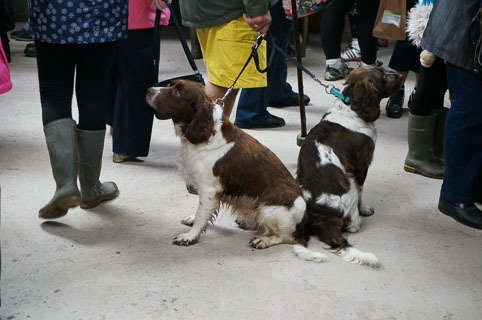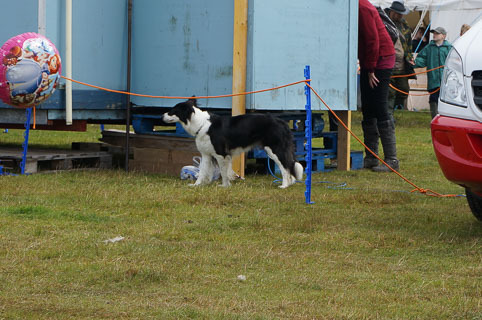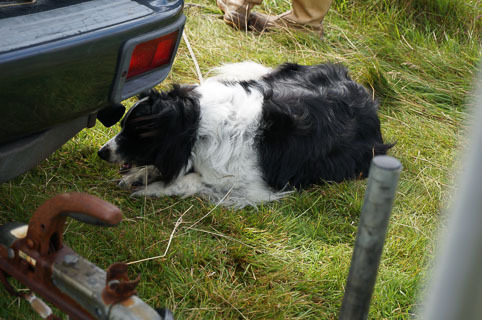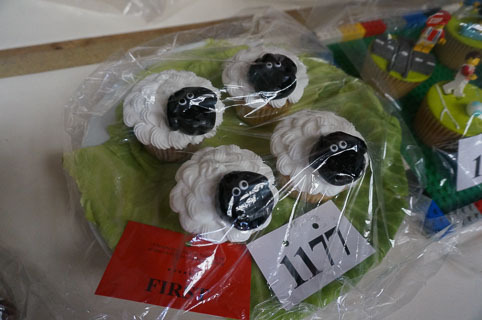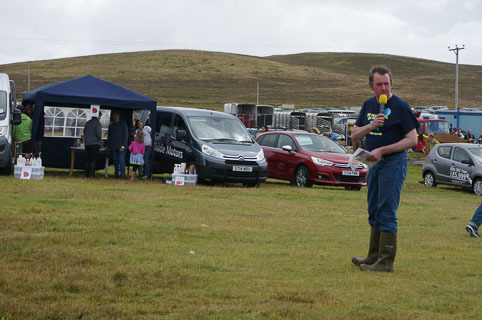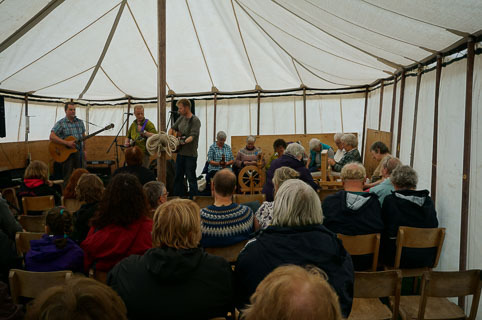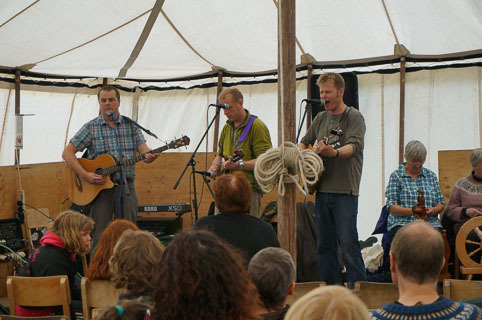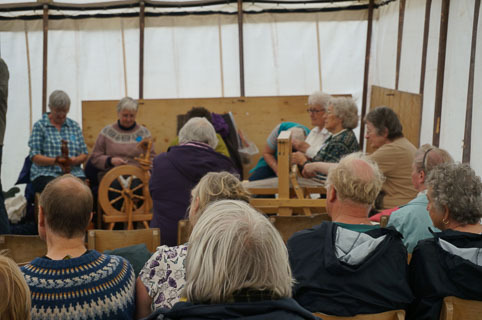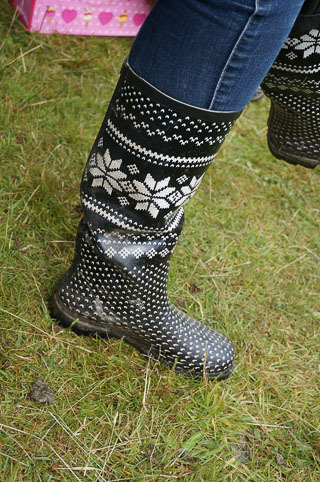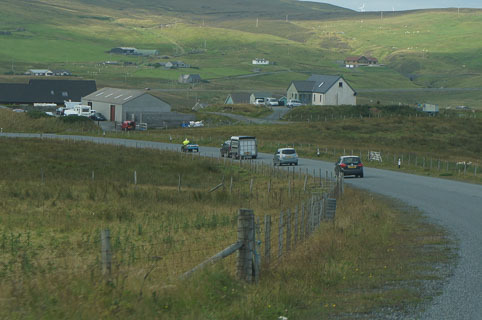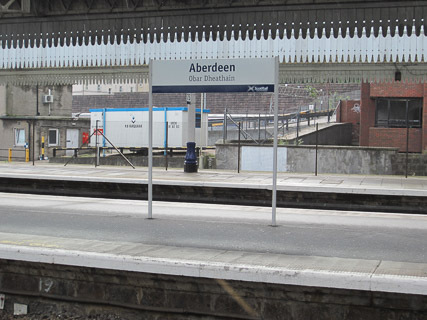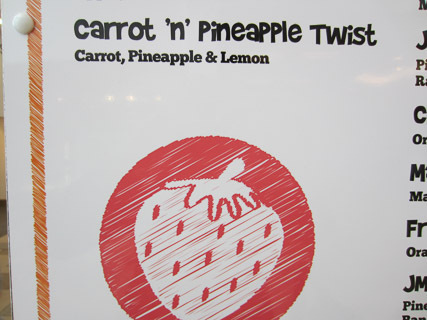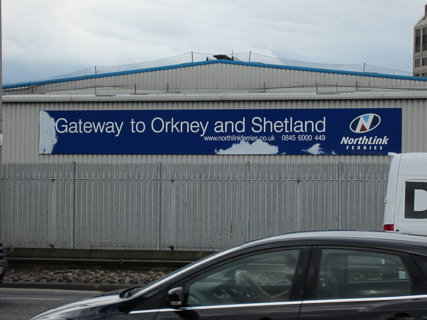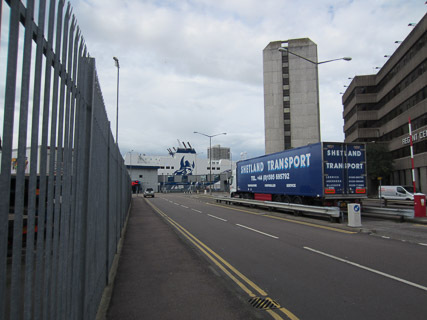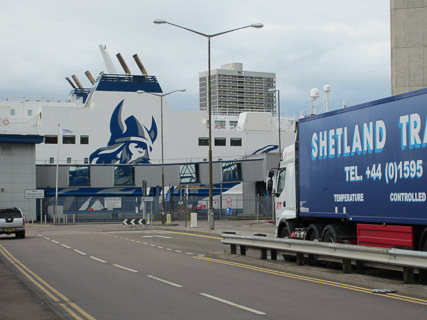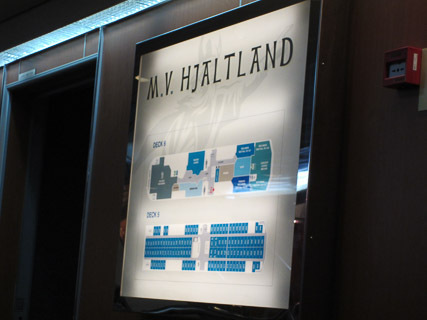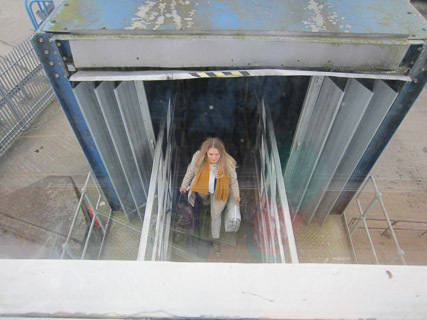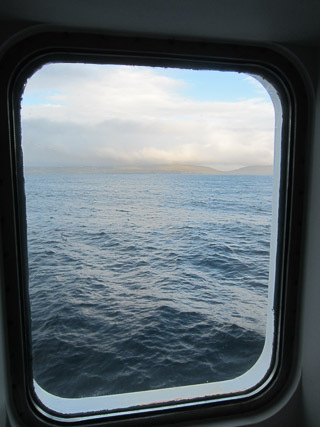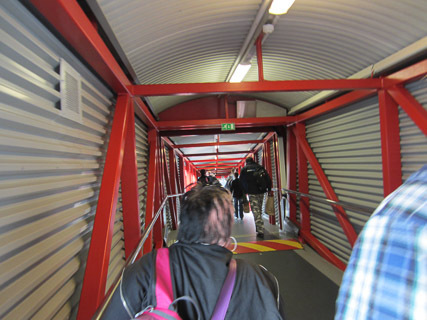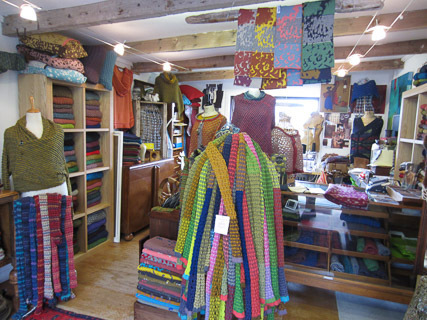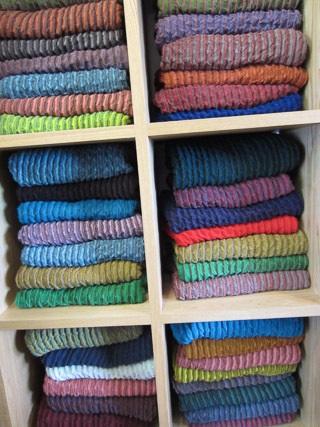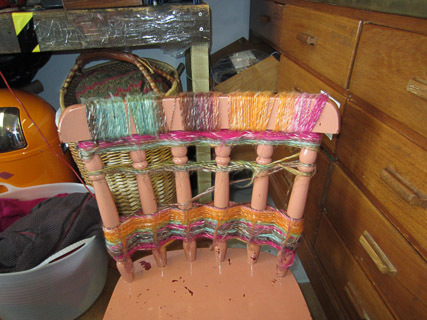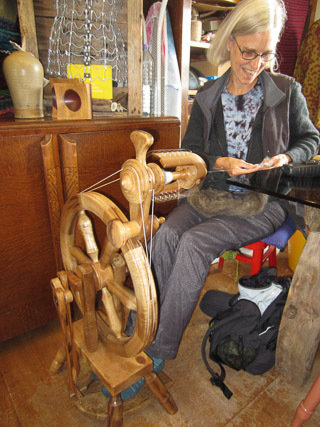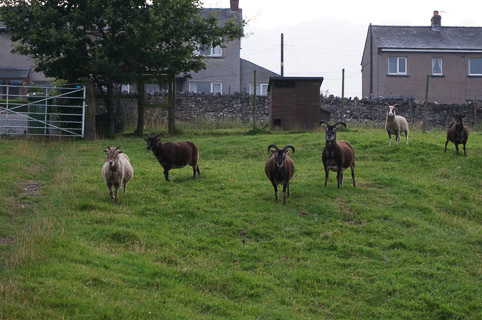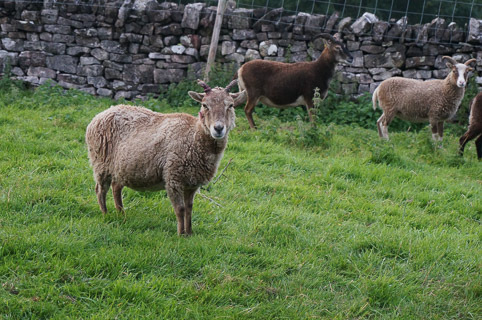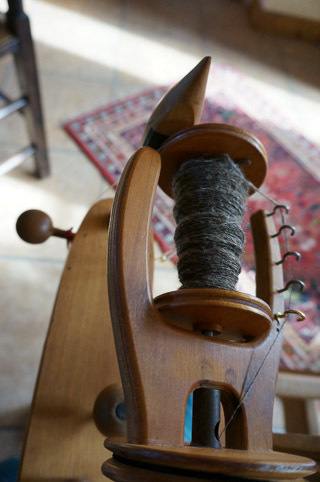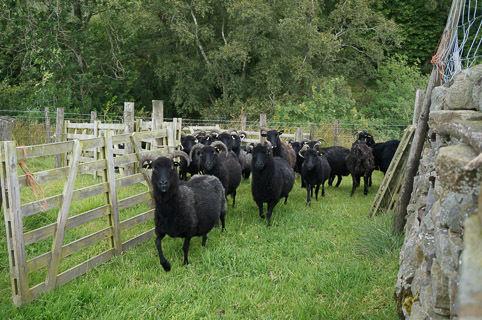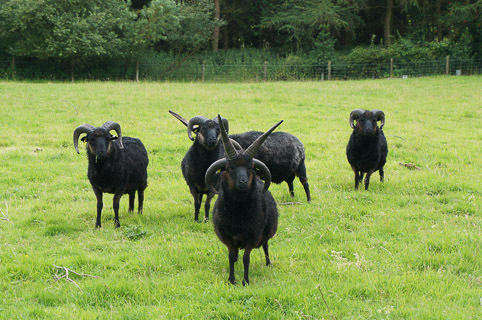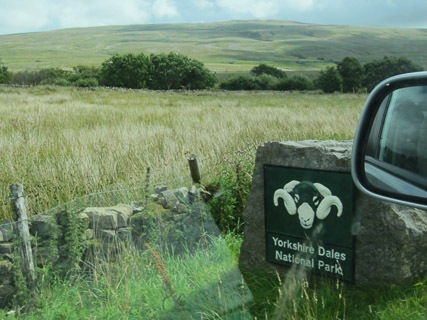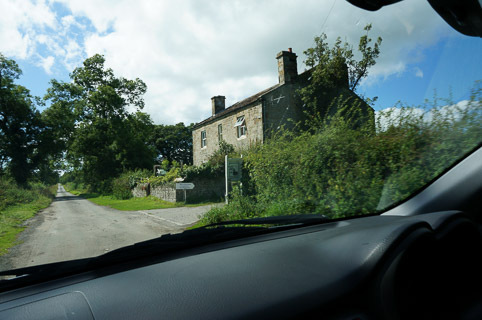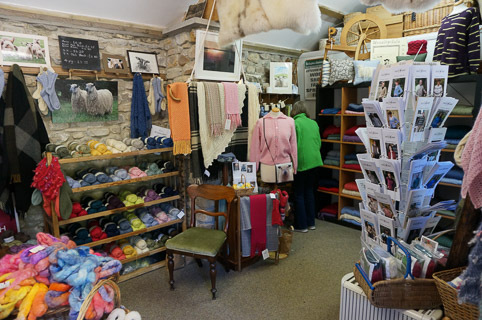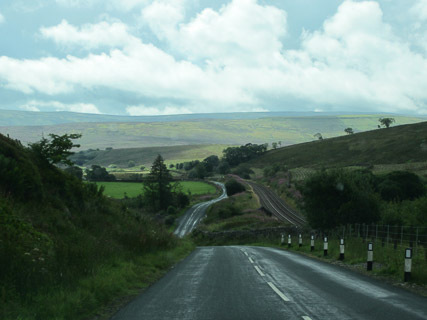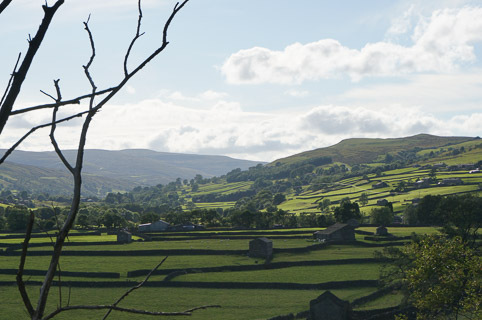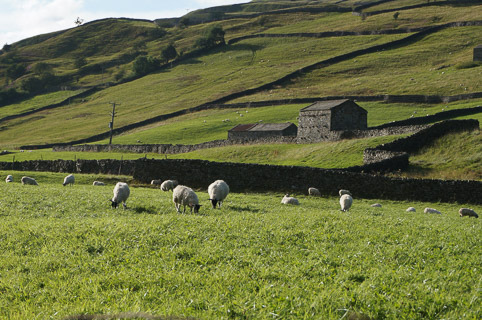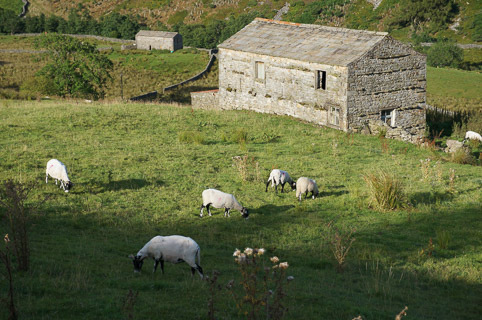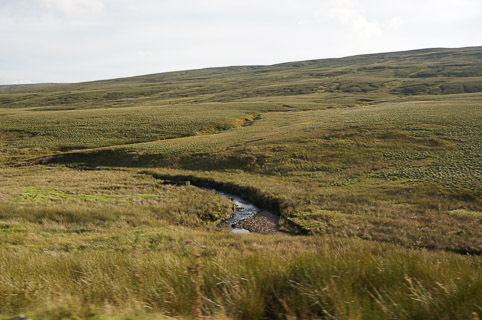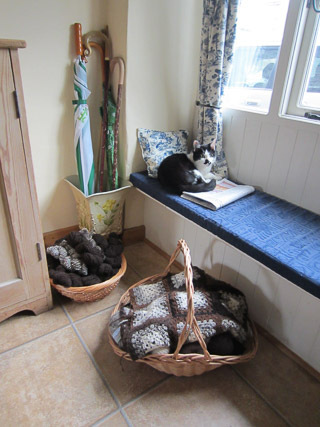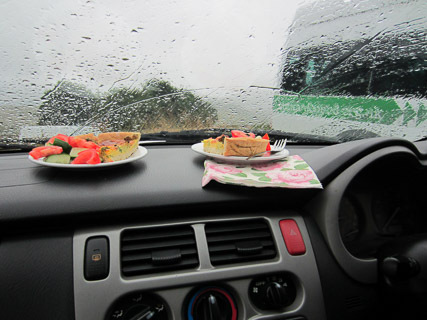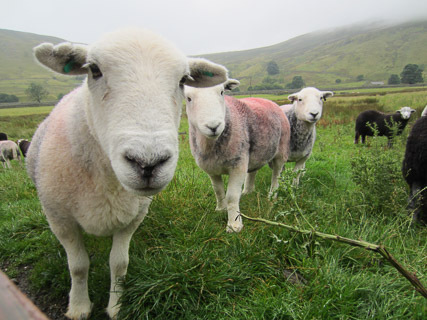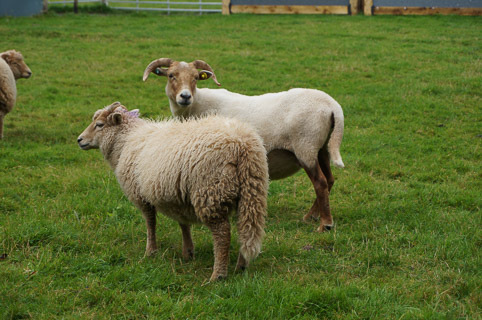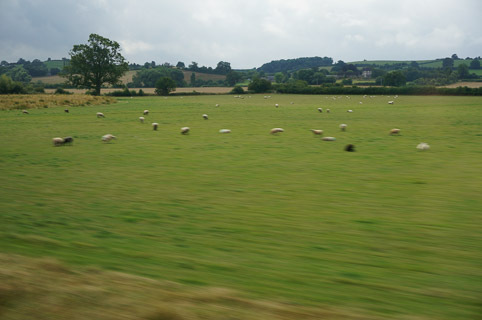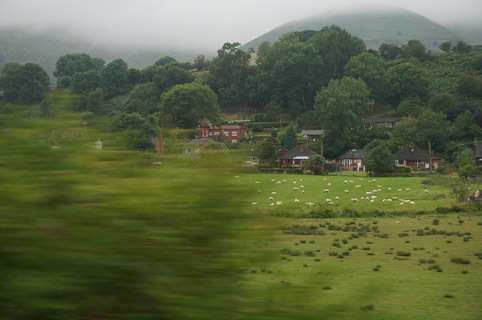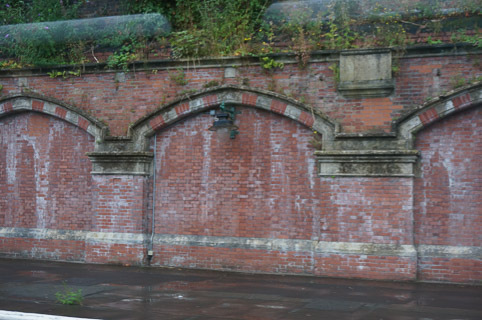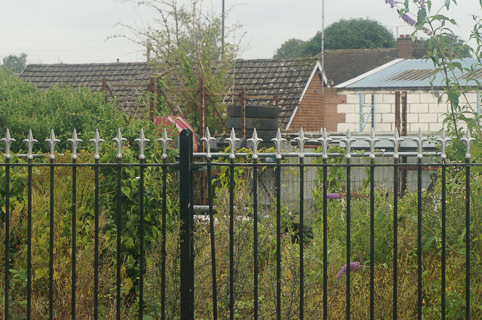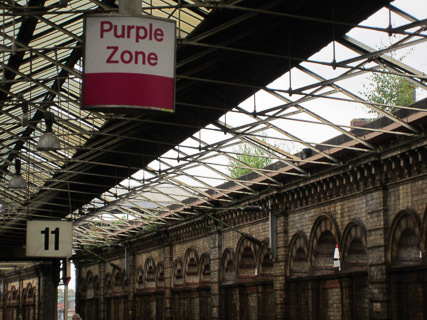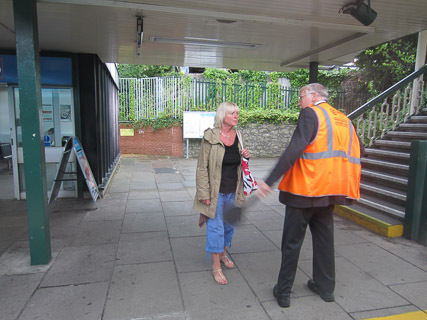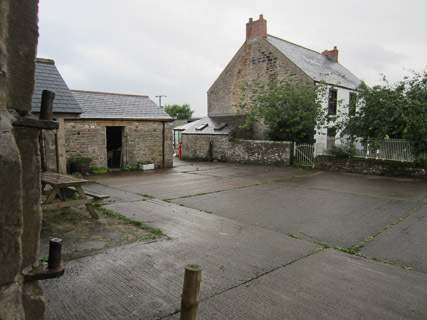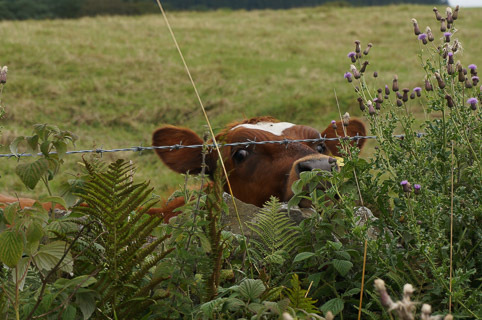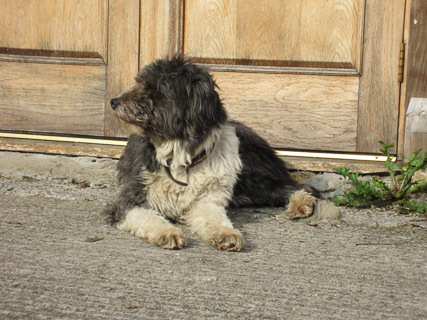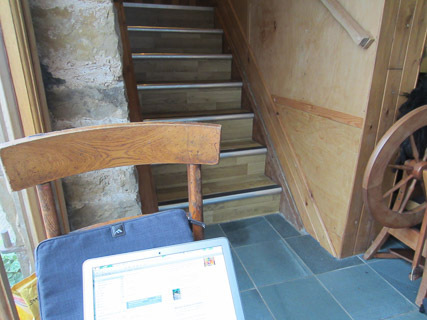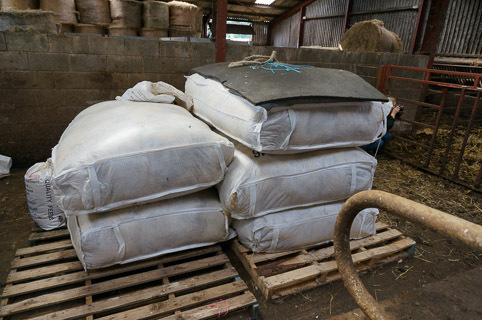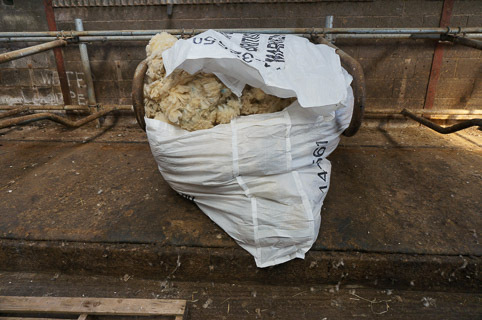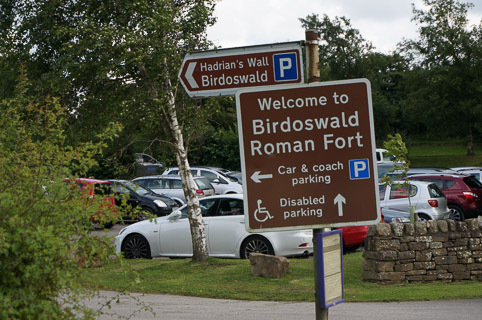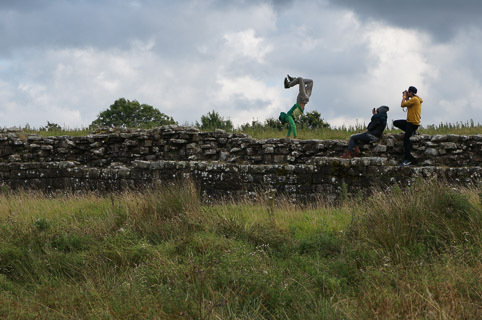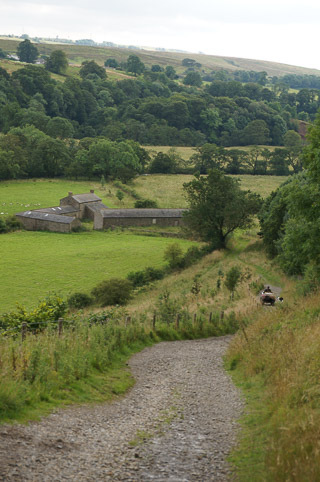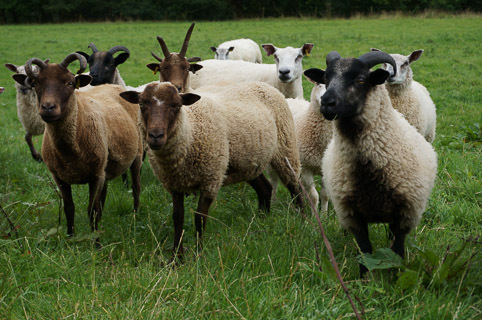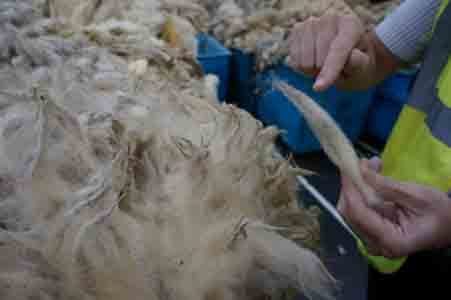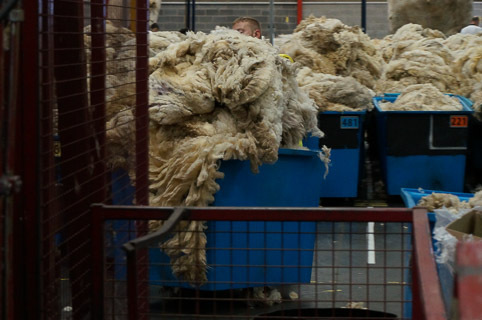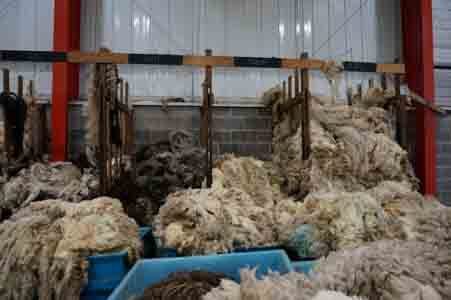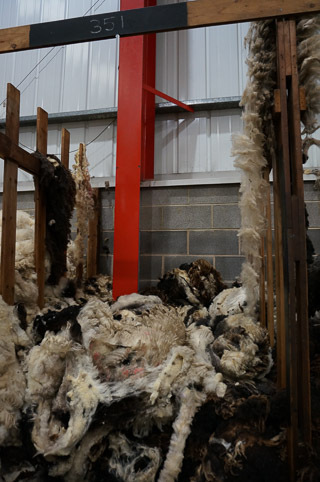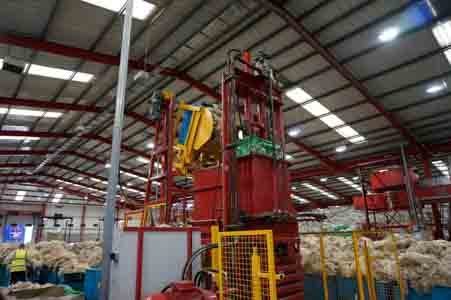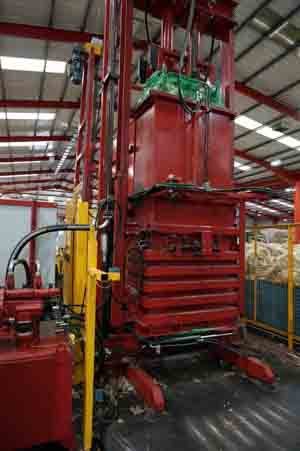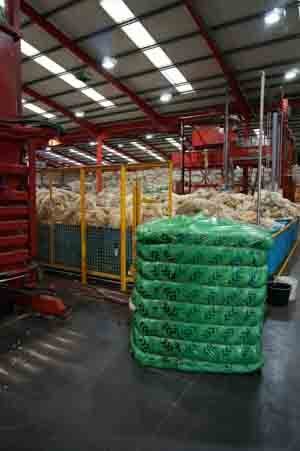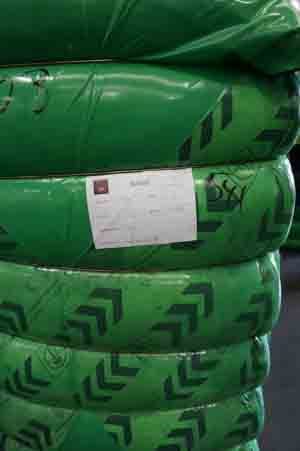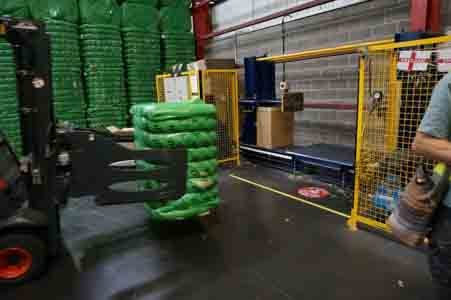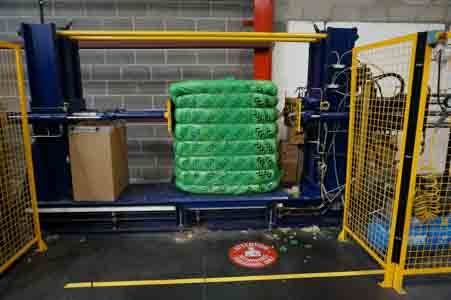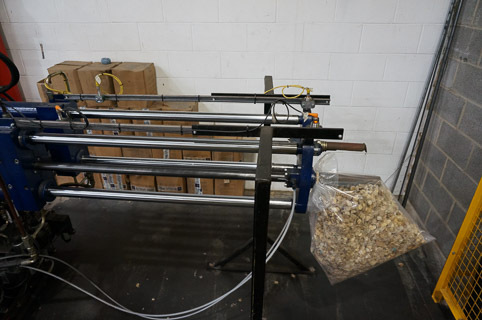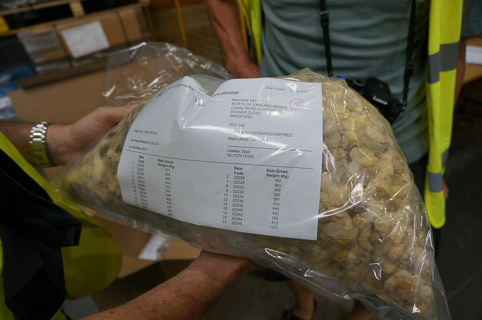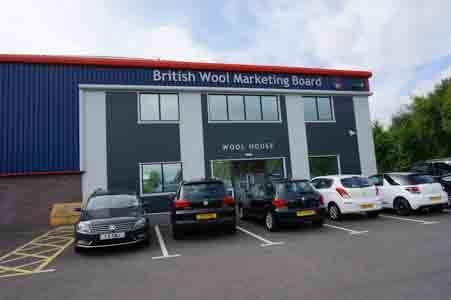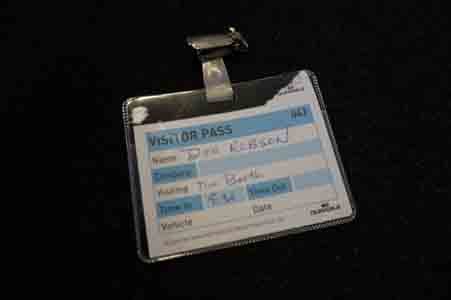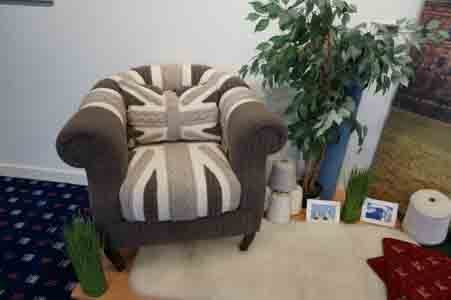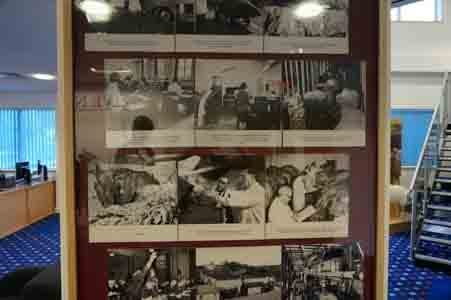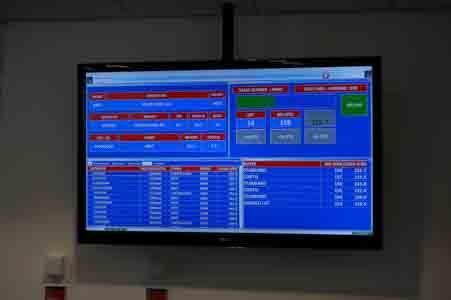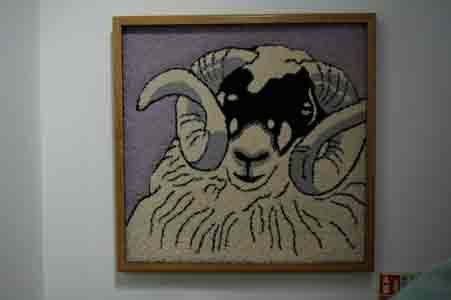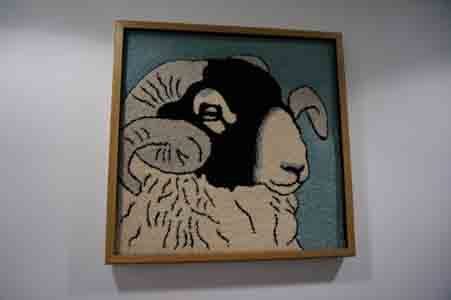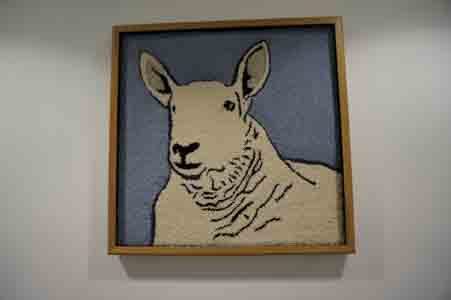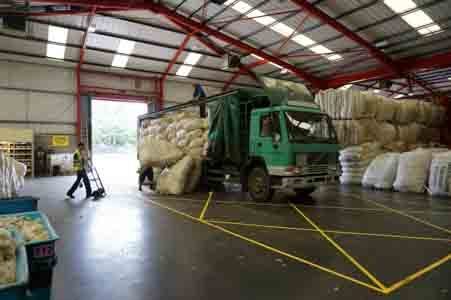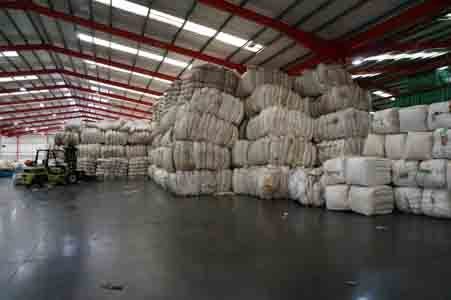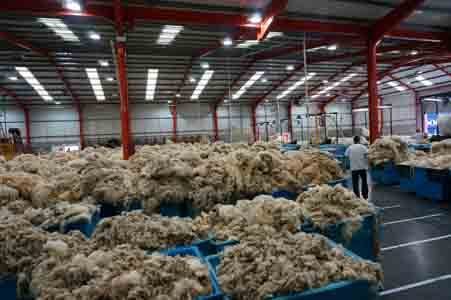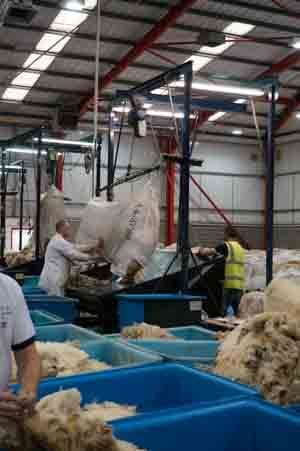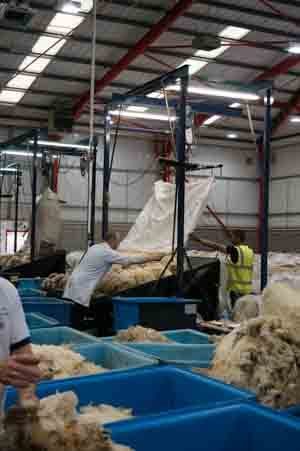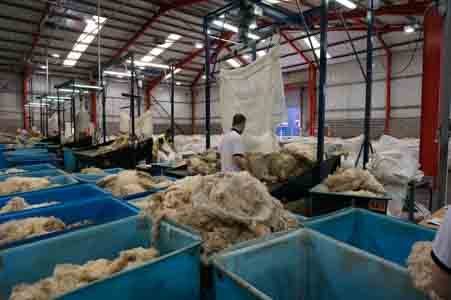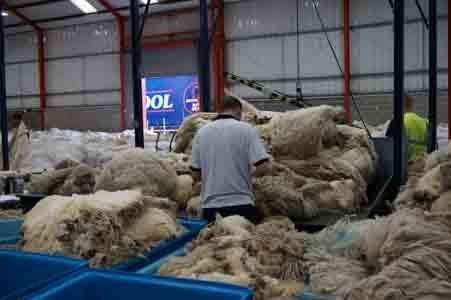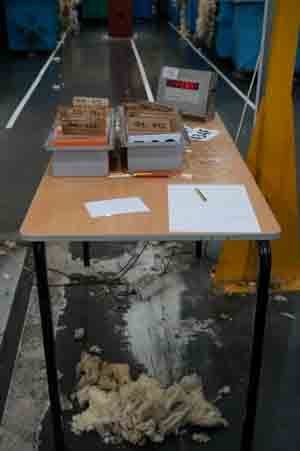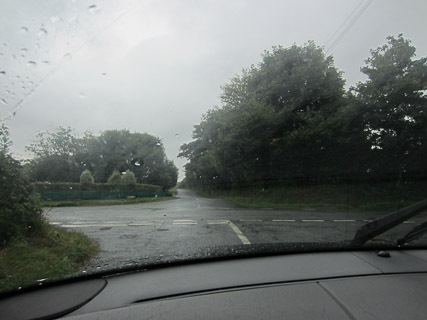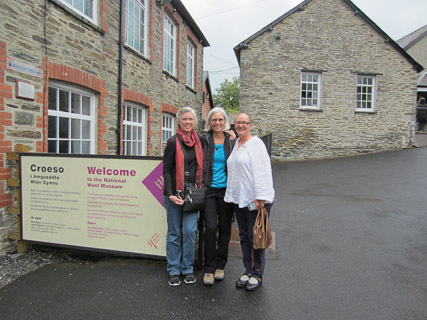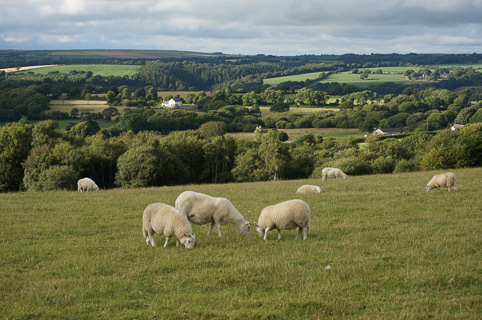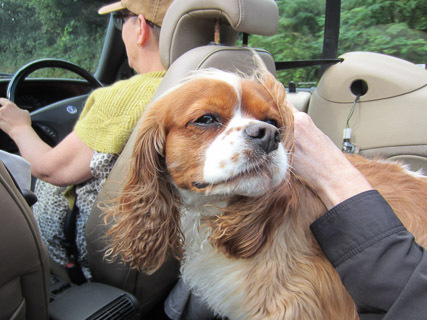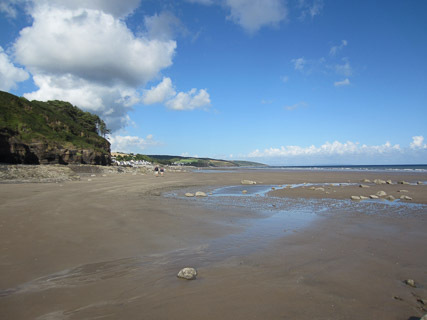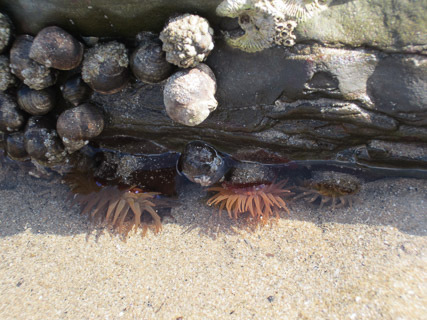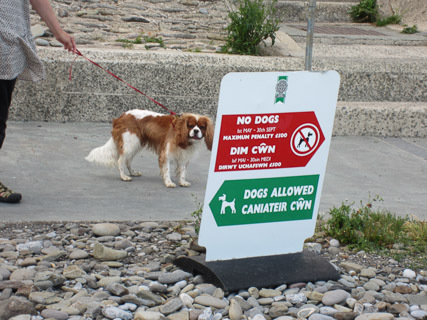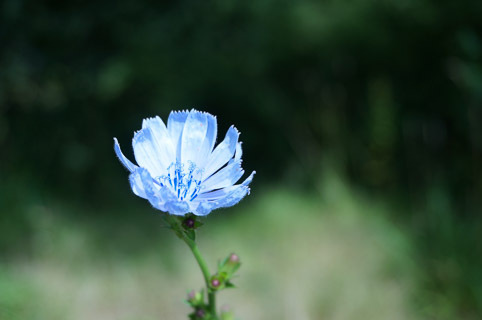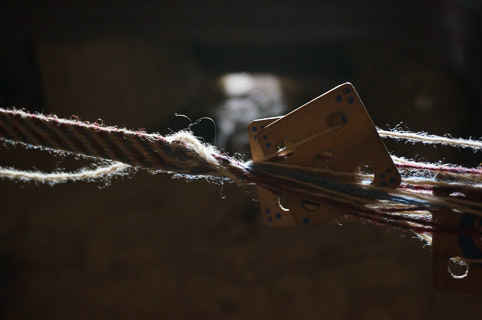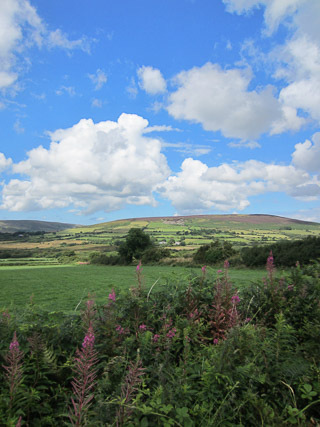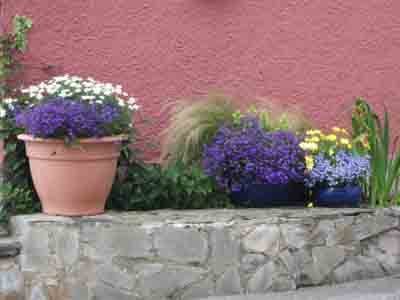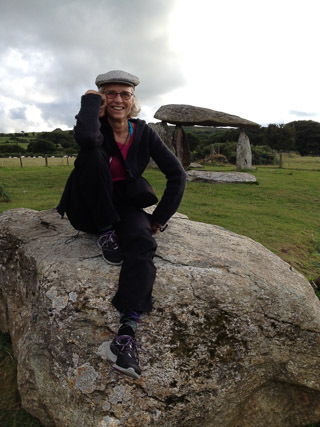Deborah Robson's Blog, page 3
August 27, 2014
Leaving Shetland and meeting Valais Blacknose sheep
I have more Shetland posts, but my time there was so precious that I focused every minute on doing things that I can't do anywhere else. I even went to the archives again on my way to the airport and looked at three more sets of documents.
Then it was time to fly from Sumburgh (Shetland's primary airport) to Aberdeen.
At Aberdeen there's only one baggage carousel for UK-internal flights, and a belt had broken on one of the conveyors used to removed luggage from the planes, so it took an hour before I could get my duffel and be on my way. Fortunately, it was still early enough that my friend Jeni Reid and I were able to visit a flock of Valais Blacknose sheep while there was good light for photographs. Jeni's photos are better than mine, but I got a few good ones.
There are two flocks of these sheep in the UK, one in Cornwall (on the southwest corner of England) and this flock that we visited in the Highlands of Scotland. (Those are both Facebook links.)
You may have seen images of these sheep on the internet, with people wondering whether they're real or toys.
They are real. It's a Swiss breed. And they are even more amazing in person than in photos: the personalities are utterly charming. It makes it a little difficult to take photos because they want to be next to whoever's around. (Well, they do go eat ultimately, but they are extremely friendly.) Here's Jeni with one of the lovely sheep we met:
Their wool falls into the vast and uninformative industrial category of "carpet wools." So many intriguing varieties of fleeces drop into that hole! Yes, these are wools that require spinners, knitters, weavers, and other crafters to let go of the "softer and finer is better" approach too fiber selection and to think of creative ways to make textiles (not just sweaters and scarves). But they reward that effort with unique experiences and beautiful, durable projects.
Valais Blacknose fleeces vary by individual (of course), but seem to grow about 12 inches (30 cm) annually, with two shearings producing solid and versatile 5- to 6-inch ((12.5 to 15 cm) staple lengths. If I had to give a sense of the hand of the wool, I'm inclined to think of the length and crimp character of some of the English longwools (with a touch of nice luster: not gloss, but pewter-like gleam) along with the crispness and fullness of Cheviot (although the crimp is quite different, so there's not the same bounce).
One more photo of one of the sheep we didn't want to leave behind, and then it's time to be on the road again.
August 17, 2014
Cunningsburgh (Shetland) show, part 3 - other fibery things
I didn’t see everything at the Cunningsburgh show, even though I think I was there for nine hours. No, it’s nowhere near as big as the major festivals in the U.S., but there was an abundance of things of extreme interest and quality. I only saw the horses and ponies from a distance, and didn’t even realize there were classes for dogs until I got home and looked at the catalog of entries more closely.
So. A few snapshots of some fibery things. It was a treat to be able to wander through the entries and admire them. When I'm teaching at a festival, I rarely have time to look at the displays of skeins and finished objects, and whenever I am (reluctantly) judging a competition, I end up feeling like I've made my commentaries in that process. I judge reluctantly because I don't like the competitive element. I judge once in a while, however, because having public presentations of craft may encourage more people to try their hands, or inspire further explorations.
Many inspiring items were put on display at Cunningsburgh. Some of them won prizes. Some things that I loved did not take home ribbons. And so it goes.
This jumper (pullover sweater) was crocheted by Jane Outram. Terrific crochet.
Very gifted in multiple techniques and color use, she also made these bands with card- (or tablet-) weaving:
She used woolen-spun jumperweight (fingering) yarns from Jamieson & Smith (not the same as Jamieson’s). Card-weaving really stresses the warp threads—and produces incredibly strong bands, partly because the component strands need to be very sturdy and partly because of the structure itself. I asked Jane if she’d uptwisted the yarns (to increase their strength) and she said she hadn’t. That’s quite a testament to the integrity of those yarns. Not many woolen-spun yarns would stand up to card-weaving.
Jamieson & Smith also makes worsted-spun jumperweight yarns, although in a very limited range of eleven colors. (And they’re about to introduce worsted-spun aran-weights, one of which I’m sampling right now. The worsted spinning not only strengthens the yarn but brings out the wool’s natural luster. I can’t break this stuff with my hands, although it’s still lightweight.)
I found the color use and design of the bands absolutely enchanting.
But moving along. . . .
Nearby was this piece, which I initially thought was needlepointed (in petit point: the stitches were tiny). But no, those stitches were square and it was cross-stitched: densely, to create a solid image that nonetheless didn’t distort the foundation fabric. TINY, TINY stitches!
It was made by Louise Jamieson. It was one of those works of art that looks great from a distance and also reveals even more when closely observed. The background was worked in a lighter weight of thread so the figure was in slight relief—effective, but you really wouldn’t consciously perceive the shift unless you were peering at the work quite intently.
Several people who noticed the image as I was standing nearby spontaneously and easily identified the person shown.
The costume is one from the Up Helly Aa winter fire festival. There are fiber stories involved in the squads’ costumes, too, but that’s for another day.
Back to the Cunningsburgh show, and a few of the remarkable items I saw, this time in the building that contained the baked goods and most of the knitting and spinning.
One interesting category was the “Colourbox Competition,” for Fair Isle items made from at least four shades of eight specified colors.
Knitted cardigans (by Barbara Isbister, Barbara Johnson, and, again, Barbara Isbister):
Jumpers (pullovers, left edge and center by Barbara Isbister; I managed to miss the identifying number for the one on the right edge):
Gloves (these were handspun, by Anna Simpson):
A gorgeous lace shawl (by Yvonne Robertson):
And another inventive scarf (by Mavis Ross):
Handspun skeins (by Elizabeth Johnston, Mavis Ross, Julia Downing, Anna Simpson, and Alexis Keith):
And, in another area, some fleeces. . . .
(AQR Cross, managed by Hamish Hunter)
(Jane Outram . . . see the crocheted jumper and the card woven bands above)
And I can’t resist including this final photo from the sheep area, where a group of gentlemen were having a discussion.
August 16, 2014
Cunningsburgh (Shetland) show, part 2 - sheep
It was easy to spend most of my time around the sheep area at the Cunningsburgh show. There was a lot going on. Initially sheep were arriving and getting settled into their pens, although by the time I got there at 8:45 most were in place.
This is a not-quite-complete view of the sheep section. Shetlands were along the two rows adjacent to the ditch. Closer to the buildings and tents were the sheep of other breeds (mostly rams used in crossing) and the crossbreds.
Here’s a view of the end with the crossbreds (to the left and back in relation to the photo above).
And here are some Shetlands.
Shetlands can (and should) be “stroppy,” or lively. One was a bit too lively and escaped, not through the inadequately secured gate (which would have put it within the confines of a corridor) but over the outside barricade.
That photo was taken when Elizabeth Johnston and I were briefly blocking it from one direction and two other folks were blocking it from other directions.
It went over the ditch and back a couple of times, while another responsible party took over from our direction. The trick in getting sheep to go where you want them to is not being too direct about the whole process or they’ll bolt. Especially Shetlands.
When this one was captured, it was put in JAIL, with a barricade over the top of the outside half of its pen.
Not all the sheep at the show were Shetlands, although there were certainly plenty of those. In the next photo, the sheep in the front with the white blaze is, not surprisingly, a Zwartbles (black-with-a-blaze). Behind it are some Suffolk rams, dyed orange for the occasion.
Someone I met had asked one of the judges why the vivid and unnatural color had been applied. The answer appeared to be that this was so people could tell where the ram was when he was in with a group of ewes out on the hills. I’ve also heard of sheep being dyed colors either to prevent thievery or for reasons of playful artistry.
Here’s a closer photo of a young Suffolk ram.
And an undyed one, behind a Shetland that won a lot of ribbons—in part to show the size differences between the sheep. The ram in the background isn’t even one of the biggest ones. Admittedly, the Shetland is a young ewe, but she’s full-size Shetland.
There was a handful of Scottish Blackfaces.
And some Texels.
And quite a few Cheviots.
The Shetlands were in three groups: white, moorit, and “any other colour."
Judging started at about 10 a.m. and ended around noon.
First the individual classes were judged: many of them, including (for the white sheep) tup (ram) older than three years (“aged”), tup two and three years, tup one year, tup lamb; ewe, ewe with lamb(s) at foot, ewe lamb, gimmer (young female not bred yet), ewe with crossbred lamb(s) at foot. Similar but not identical groups for the moorit and “any colour not included above” groups. I’m just looking at Shetland classes now, because that was where I paid attention.
After the individual classes had been completed, cross-class judging occurred within each group (example: Best Coloured Shetland Sheep), and then across the categories (champions and reserve champions and best of opposite sex).
One of the award decisions within the colored sheep section came down to a choice between this handsome ram:
and this lovely ewe:
Almost all of the judging took place with the sheep staying in their individual pens, but in this case the judge had the two sheep brought into a single pen for side-by-side comparison.
His final decision seemed to come down to extreme niceties of wool quality. (By the way, all of these sheep had been rooed (had shed their wool) or been shorn relatively recently.)
They were very close, and he examined the wool at a number of places on each sheep, taking his time about it.
The ewe took home the ribbon, although on a different day the ram might have.
Isn’t this a handsome ram (tup)? One of the things I learned just by hanging around the sheep pens is that you can tell the age of a ram by the growth sections on his horns. This fellow is four years old.
One of my favorite Shetland sheep wasn’t even part of the big judging process. It was in the children’s pets category.
And on looking at the show catalog, I’ve just discovered that I completely missed the sheepdog classes. Well, I may need to come back another year.
(2,833 entries. No wonder I didn’t see them all.)
August 15, 2014
Cunningsburgh (Shetland) show, part 1 - overview
I’ll be ever-grateful to Elizabeth Johnston for the heads-up (before I’d booked my travel to Shetland) that the Cunningsburgh show would be happening on August 13. I was able to arrive in time to see the show in its entirety, instead of arriving two days late. I had to sacrifice an open spinning day in County Durham to accomplish this, but assuming I get another trip to the British Isles it is easier to schedule a trip to County Durham than it is one to Shetland, especially since I wanted an unbroken chunk of time for research here.
At present I envision three posts on the Cunningsburgh show, because otherwise it’s quite overwhelming, even when I keep the photos to a minimum. I’ve lined up images for (1) this overview; for (2) a post on the sheep; and for (3) a post on some of the textile crafts.
Here’s the site of the fair before it actually opened. I arrived at about 8:45 so I could get permission to hover around the sheep judging, which began at 10 and went to some time after noon. Compared to, say, the Maryland Sheep and Wool Festival, it's quite small. But there was more than enough to keep me busy, and even with all day I still didn't get all the photos and conversation that might have happened!
There was a lot of mud, and occasional showers.
I never got soaked, though, nor did I put on my waterproof trousers, although at times I thought about finding a dry spot to pull them on over my regular clothes. I got damp, but never soaked.
Animals other than sheep were well represented. As in most places, you could tell the horse-and-pony people from the sheep people at a glance by what they were wearing.
I didn’t have much time to look at critters other than sheep, but I did walk around and notice that there were, of course, ponies.
And cows (kye).
And dogs, of all types and sizes, but every one of them well socialized.
It's true, I took photos of two of the three Border collies that I saw. I have a soft spot for Border collies.
The baking competition ranged from plain pancakes to elaborately decorated cakes, with everything else in between. This comparatively simple entry caught the judges’ attention, as well as mine.
One thing that I enjoyed was that the show’s announcer had a cordless mike and walked around the site letting people know what was going on and what they might want to be prepared to go enjoy. That included two sittings of a mid-day dinner, in a building across the road, and live music starting at 2 in the afternoon.
A couple of times he made an announcement asking a particular person to please go to a specific location, "preferably with a dog."
I got to hear part of the music, although not as much as I would have liked. When I was in the music tent, it was fun to see the front spaces shared by musicians and fiber folk—the latter engaged in all parts of the process, from carding through spinning and up to knitting and weaving (yes, there was a floor loom—on the far right).
During the brief time in the mid-day when I found a bench and sat down for a bit, I couldn't help noticing the practical footwear on the young woman next to me.
And as we drove away from the show, the line of traffic to the north was led by a fair participant who had entered an enormous cabbage—it was the size of a small sheep, and she carried it in a trailer attached to her four-wheeler.
Elizabeth, who was taking me back to my lodging, said, “She’s going all the way to Gulberwick, and there’s a stock trailer behind her, so this is the speed we’ll be going.” And everyone seemed happy with that situation at the end of a long day in the rain and sun and a bit of wind.
More to come: sheep, and a few craft highlights that caught my eye.
August 14, 2014
Aberdeen to Shetland
I came into Aberdeen on the train from Cumbria.
It’s a big station, and a friend had helped me with how to get from train to ferry, and the internet and the same friend helped me figure out that I’d better eat at the shopping mall adjacent to the train station, because there’s nothing at the ferry terminal, which is, in fact, an easy walk away if you’re not in a hurry or too laden with luggage.
So I got some food at Marks & Spencer for the voyage, and topped off my snack-lunch with juice from a place called Juice Master.
It’s apparently a THING. There’s a lot of jazzy promo on the site about how the stuff will cure everything that ails you, but it just looked like it would taste good. It did. Superb. I did get a simple mix: yum. If we had these at home, I'd visit often.
My order at the stall (stand) also evoked a question from the person who took my request that I think was in response to my accent. She said, “It will be at room temperature. Is that okay?” I said, “Sure,” without really thinking about it. In fact, I think the flavors were enhanced by its not being chilled.
But I was thus a bit more prepared when I bought milk on the ferry the next morning to put on my granola and heard, in a somewhat apologetic tone, “We only have this kind [indicating whole milk]. Will that be all right?” Again, yes. And I’m guessing that for some folks with American accents the room-temperature juice and the lack of alternatives in milk fat content might have been problematic.
In the parking lot of the shopping center, I had to take a photo of an electrician’s van. I don’t think I’ve ever seen my family name in this type of context. Or maybe on any business.
Dreaming of Shetland: the journey starts in earnest here (with thanks again to everyone who has contributed to the project, in large ways or small).
Crossing the intervening street took quite a while: pushing crosswalk lights and then waiting, with only one phase of the crossing greenlighted at any go.
And then the walkway to the terminal.
Yes, that’s the ferry out there past the terminal building, with the Viking-esque fellow on it. (I wonder what the women's equivalent would be?)
As far as I can tell, the two boats that run this route are the Hrossey and the Hjaltland. This evening’s journey was on the latter. Boarding begins two hours before departure, and you have to check at least a half-hour before. The sailing is 12.5 hours, leaving Aberdeen at 7 p.m. and arriving in Lerwick, Shetland, at 7:30 a.m.
This next photo is of the (mostly) covered walkway for foot passengers, as seen from the ferry after boarding.
I needed to book my ticket a little later than I would have wanted to in an ideal universe, and no cabins were available when I made my online reservation. Fortunately, I was at the terminal early enough to snag a bed in one of the two-berth shared cabins that had opened up. There ended up being a waiting list for cabins of any type, and not everyone got one. On that long a trip, it’s good to be able to lie down, take a shower, and withdraw from the noise level in the main portions of the vessel.
This is what most of the journey looked like. The view is from cabin 230 on deck 5 when we were about an hour out of Aberdeen. Later it got darker, then lighter again, but for most of the journey there's a whole lot of water out the window.
There was a rolling swell between the exit from the Aberdeen harbor and a short way past Fair Isle, which is the southernmost island in Shetland. Then it was very smooth for a bit, with a little chop at the end. My cabin-mate said she is not a great sailor and would spend the voyage in a horizontal position. That worked for her. She was good company, and I’m glad she’s figured out a way to manage the ferry since she’s been doing the journey annually for twenty years.
The next morning, mainland Shetland came into view.
Here’s the passenger exit from the ferry.
Car drivers go down first to begin removing the vehicles from the several lower decks. Then foot passengers disembark. You can stay on the ferry and have breakfast, if you like. If you’ve driven your car off, you can come back on and meet the rest of your party for breakfast and a slower wake-up period.
Me, I was ready to get my rental car and find my lodgings. And take a 90-minute nap, even though I’d slept reasonably well on the ferry.
Then, in part to practice UK driving and also to begin my orientation process—and not least to see someone I already consider a friend, even though our interactions had been most detailed through e-mail—I drove to Hoswick to visit Nielanell, whom I’d met last October when I was in Shetland for Wool Week. She's an outrageously creative, precise, wild, and inspiring textile spirit. We were both so crazy busy last fall that we hadn’t had a chance to talk.
We began to make up for our ships-passing-in-the-night conversations of last year. I visited her amazing shop. . . .
It’s a feast of color and texture and brilliant design. Here's just a wee (or peerie) sample of one corner:
As well as serendipity.
Niela balances control and abandon in her various fiber pursuits.
And I was able to spin for a bit on the myrtle spinning wheel Tom Livernois had made for her. I’ve followed its progress from somewhere in the making process through transport (it was stuck in Aberdeen for a while because of wild weather) and it was so fine to spin on it here in its new home. What a gorgeous tool! It treadles beautifully, is exquisitely balanced, and although it’s comparatively lightweight, it stands solidly on the floor. Neila’s friend and helper Samuel took some photos. He's been assisting her since he was 12. That's been a significant chunk of time, and he's at the stage where young adults decide on initial future careers (I tend to think that many of us end up in serial career adventures, whether we plan to or not). I hope and trust his path will include some textiles. He has a gracious and appreciative relationship with them.
I’m spinning a bit of Badgerface that I brought with me (which June Hall had put in my hands in Cumbria). So far I’ve spun with that fiber on a 1970s-era Ashford Traditional; my traveling spindle—a Magpie Maggie top-whorl, made for travel and a delight at home and abroad; and Tom’s myrtlewood wheel, based on Magnus Drudik’s design and an extremely worthy successor to it (and with a six-year waiting list for the wheels, this was my most likely opportunity to enjoy the experience of spinning on one). Quite the set of contrasts!
Here’s the funny thing about Badgerface sheep. There are two types: torddu (pronounced tor-THEE) and torwen. Torddu means “black belly,” and these are the sheep with the light fleeces. Torwen means “white belly,” and these are the sheep with the dark fleeces. So the light-colored ones have “black” in their name and the dark-colored ones have “white” in theirs.
August 13, 2014
More sheep, in case you're curious
So I spent a couple of days in Cumbria with June Hall. She knows enormous amounts about local history, geology, plant life, and, of course, sheep and the people who keep them. It didn’t rain as much as the forecast suggested it would, although we (and the sheep) got wet. They take it in stride. When they shake, it flies off their woolly coats just as it should.
We saw a bunch of Cumbria and some of the Yorkshire Dales, specifically Wensleydale and Swaledale. It’s so good to see these landscapes. I’d love to do a study with photographs of the breeds in their places of origin. Wouldn’t that be enjoyable?
First, though, there is June’s small flock of Soay sheep, who live right next to her house.
The light one (without the white face) is matriarch Beauty, whose photo I took four years ago and have decorating my iPad mini. Beauty is now 16 years old.
June gave me some Badgerface wool to spin. It’s a rare breed here in the British Isles, and there’s a photo of some of the sheep later in this post.
June’s already spun up enough for an everyday sweater.
We went to see Hebridean sheep: these are the ewes. They thought we had edible treats for them. Alas, we did not, so they left almost as quickly as they arrived.
The rams were a bit less eager and also less quick to run off.
This is the flock from which the samples in The Fleece and Fiber Sourcebook came. They would have been interesting anyway, but that was special.
On the Dales visit, we traveled one way through Wensleydale, and the other way through Swaledale. Very different landscapes, in adjacent long valleys.
We visited the Wensleydale Sheep Shop. I have used some yarn that comes from here, which I purchased at the Maryland Sheep and Wool Festival. It was great to see the place itself.
Wonderful inside:
Here’s a series of images from the day, which I’ll need to sort out later—some parts of the Dales are cultivated, and some are remote. The physical distances are not large, but the geographic and mental distances are.
This was who greeted me the next morning before we went out again. This cat does not live here. Except he thinks he does. (There is another cat who does live here. I saw him a bit less often than I did this one.)
Both days we took picnic lunches with us. The first day we ate in the car because of the wind (and a bit of rain). The second day, this one, we ate in the car because of the rain (and a touch of wind).
These are the Badgerface sheep (in front). The dark-bellied one with white wool is a torddu. The white-bellied one with the dark wool is a torwen.
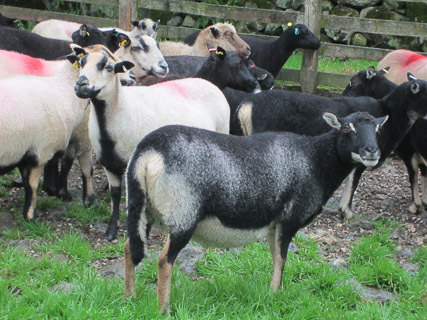
We also saw sweet and wonderful Herdwicks: they get redded up for shows. The darker ones are the youngest.
We ended the day visiting a flock of Portlands. Moms have been shorn, youngsters not.
I’m skipping so many details! And a lot of photos of rain.
August 12, 2014
The days are whizzing past: workshops in Gilsland
I keep putting together images and then not having either time, an internet connection, or both to get them posted. I’ll need to catch up with Yorkshire and Wales later. I arrived in Shetland this morning, so let’s get up to the Cumbria/Northumberland piece, at least.
I got on another train and saw more beautiful Welsh and English countryside. I don’t have any brainless knitting with me—no time to set up a project before I left home, so what I have with me is compact but requires both good lighting and attention on every row—and I have not yet found a bookstore with anything that I want to read, so I’ve been trying to take photos.
It’s very hard to study or photograph sheep while in a vehicle going between 50 and 60 miles per hour.
As soon as I click the shutter, shrubberies frequently attack.
It's not like I could see the sheep very well anyway. So I focused (literally) on what I could observe when we would stop at stations.
The good news is that the stations all seem to have extremely distinctive details.
I transferred from one train to another at one point.
I’m getting better at navigating here by train. It helps to know that even the locals are not entirely sure what to do or where to find the board with the departures listed (which sometimes, in some stations, doesn't have a display for a while, making it even harder to locate).
Ultimately, I got to Carlisle, where I was picked up and, along with my friend Jeni, transported to Slack House Farm, an independent hostel where we stayed while I taught for two days in nearby Gilsland, a town that is half in Cumbria and half in Northumberland.
The neighbors are charming.
As are the residents, both two-footed and four-footed. Although Bessie (below) was not allowed inside at certain points because she tended to get into things. Sometimes she was aromatic and sometimes just wet. But she was very sweet.
I did have some challenges getting an internet signal, but thanks to a hotspot supplied by a friend (which worked when placed not even a smidge more than 4 inches from the window) I was able to keep up with the basic communication needs, if not blog posting.
The farm next door is where some of the sheets that end up at the British Wool Marketing Board start out.
This one still hasn’t been filled.
We were near a portion of Hadrian’s Wall. The visitor centre looked very interesting, but we didn’t have time to check it out.
We did walk along a section of the wall on the way to visit some sheep. Other people enjoyed the top of the wall.
The sheep were in the bottom land nearby, close to the stream. (I walked it.)
Aren’t they lovely?
Those are just some of them: the braver ones.
The site of the two full-day workshops was the Gilsland Village Hall. I had a superb time, and I hear that other folks did, too.
There’s more to say, but no time to say it!
August 7, 2014
The British Wool Marketing Board, part 2
Continued from yesterday, a visit to the British Wool Marketing Board, in Bradford, West Yorkshire, England. . . .
___
Graders are looking at length, color, strength, and cleanliness of the fleece. For example, if there’s too much vegetable matter, the wool goes into a bin with the correct grade number followed by a V.
Trolleys are carefully labeled and organized by grade.
Along one wall are some vertical holding areas for unusual wools: colored, and so forth. There aren’t as many of these types of wool so they take longer to accumulate and be ready for the next phase of management (baling). The Bluefaced Leicesters were in this area.
So were the Jacobs.
Once there are a number of trolleys of a particular type, their contents are dumped into a baler. See the little bright blue bit in the yellow mechanism at the top of the baler? That’s a trolley, being upended.
You can see its next motion here. There were two balers. On one, the trolleys emptied with one tip-and-bounce. On the other—perhaps a greasier type of wool—it took five or more tip-and-bounces to empty each container. I didn’t have an opportunity to count how many trolleys go into a bale. I can reverse calculate the amounts from my notes, but that will delay this post. . . . It’s a significant quantity. . . .
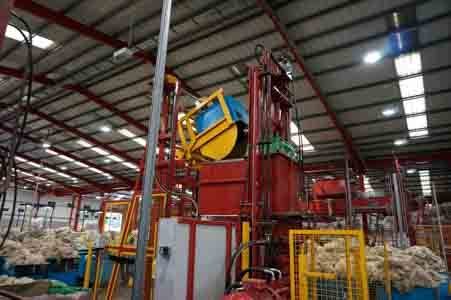
The wool is compacted into the bale.
Wires are wrapped around it loosely, and when the bale comes out of the baler the simple expansion of the wool tightens the wires.
Each bale gets a label. . . .
and is then transported to the coring unit, which will be used to test the quality of the bale. This generates the information on which the buyers at the auction base their bids.
The pressure plate on the left simply pushes the bale up against the coring mechanism on the right, which has an outer cutting edge that removes a section of plastic and an inner boring device that goes all the way through the bale and extracts a section of the wool for testing.
This is what the core selection looks like just after it’s been bored out.
This is a core sample labeled and ready to go to the lab for analysis.
And now a couple more photos of the main area. This is right by where the graded and sampled wool is stored, pending its sale at auction and delivery to the buyer.
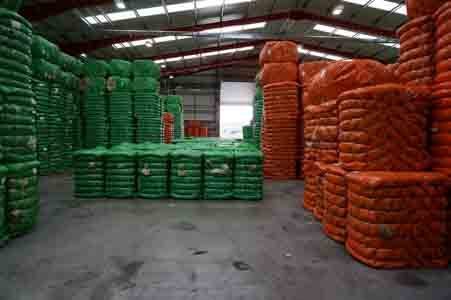
And I like this one, close to where we came into the warehouse, because it catches a glimpse of so many aspects of the wools’ travel through the area.
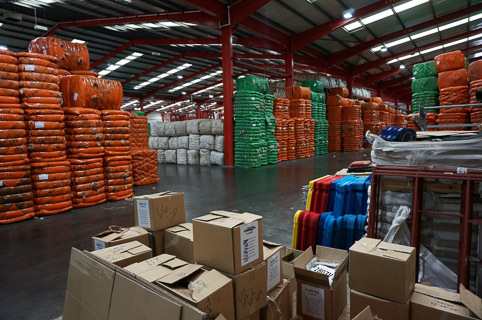
By the way, there appear to be just over a dozen very skilled people running this entire operation, with some seasonal help to, for example, move trolleys around. That includes both office and warehouse staff. It’s pretty amazing.
August 6, 2014
The British Wool Marketing Board, part 1
I’ve got better photo export settings figured out, but I also have set up three posts with test versions 1 and 2, and if I stop to rework them I’ll never catch up. So apologies for the blur in the images. On we go.
____
In two days, I visited several sites important to the understanding of wool production and processing. The first, which I’d anticipated seeing for years before I got there, was the British Wool Marketing Board (BWMB). Tim Booth, who showed me and a friend around, had been instrumental in obtaining several samples for The Fleece & Fiber Sourcebook. We only approached him after we’d exhausted other options (or at least the time we had in which to pursue them) and he sent a wonderful box that filled multiple gaps. I wanted to say thank you in person, and to see what the BWMB is like.
The organization moved into a new building in 2012, so what I saw was not what I would have seen if I’d gone earlier. The business and its details are undoubtedly similar. The headquarters are in Bradford, along with the largest warehouse and processing facility. There are several other sites where wool is physically handled, but this is the big one. The BWMB was established in 1950 and buys wool from all growers who have more than four sheep (three being the approximate number to supply a family’s annual needs, and four being the start of a “surplus”—different breeds having different fleece sizes, and so on, but they had to have a practical number). There are exceptions for rare breeds and for some fleeces to be held back and sold to spinners, and the Shetland growers as a whole chose not to be included (an option I’m guessing they had because of their geographically separate situation, although I need to look into that a bit more). But overall, the BWMB manages all British-produced wool, and makes it possible for British farmers and shepherds to compete on the world market. Without the board, there would be scattered amounts of diverse types of wool, never in quantities large enough to make an impact. Interestingly, the board never owns the wool. It acts as an agent between the farmer(s) and the buyer(s).
So here’s a quick overview of what happens there. We found the building, located in Bradford.
Signed in, and got badges.
In the entry area there are displays of some ways in which wool can be used.
And some historic photos and narrative.
Throughout the facility’s non-warehouse areas there are gorgeous carpets, made of, naturally, British wool. Within the reception area, high on the wall just to the right of the photo display shown above, was a monitor showing the progress of the auction that was taking place at that time. There are about twenty-two auctions a year, with the exact number depending on wool supplies and how the overall progress of sales has gone.
More on the auction in a moment. On the walls are pile tapestries (similar to carpet pile) showing some of the breeds of sheep, each made from the wool of the sheep that it portrays. I have not yet been able to find out who made these, but they delighted me. I’ll include a few here.
This is the auction room. It is (and needs to be) extremely quiet.
Buyers must be in the room to participate, because otherwise they’re vulnerable to technological glitches from a distance. This puts everyone on an even footing. There are about 7 seconds for each lot of wool sold. They’ve gotten descriptions of the lots a week earlier, so they can plan what to bid on and how much they’re willing to pay. There are some minimums set, to guarantee an adequate return to the farmers. If a lot doesn’t reach its minimum, it is held back and offered in another auction. As we were watching, about 77 percent of the lots sold and about 23 percent were held back. That may reflect the particular raw-materials needs of the buyers at the time the auction is held. Year-round, there are about 22 auctions—slightly more or less, depending on how much wool there is to be sold.
Now to the warehouse, and a look at what happens to get to the point of the auction. I tried some panorama shots with my camera for the first time. The white bales are incoming wool.
The orange and green have been graded and scientifically evaluated. The orange are last year’s clip, likely sold and awaiting delivery, and the green is this year’s clip, possibly being auctioned at the very moment we were looking at it.
Here’s wool arriving from the farms. Those flat white packs are called sheets, and they’re loaded up on the farms.
Sheets get piled up for grading.
Here’s the grading area. Those bins (I think they call them trolleys here, but correct me if I’m wrong) contain graded wool. Grades have numbers and there are quite a few grades.
Here’s a sheet that’s been clipped to an overhead suspension device and is being emptied onto the grader’s working table.
All empty and about to be pulled out of the way. . . .
Starting to grade, pulling each fleece out and putting it into a bin. I asked how they know which ten or so grades to represent in the bins closest to the grader, and it’s by geography: if a sheet comes from a particular area, the grades it contains are likely to be within a predictable range.
It takes five years of training to become a grader.
Fleeces are weighed as they come in, and while the operation as a whole is computerized and mechanized there are still some manual bits. One of them is involved in making sure that each farmer gets an appropriate share of the income from the bale(s) to which an individual clip contributes.
To be continued tomorrow (or the next time I can get a strong enough signal to upload). . . .
August 4, 2014
A few random photos of Wales
Just so I don’t get too far behind too fast. I’ve been in Wales. I leave tomorrow for the north of England. I'm still tweaking the photo export settings in Lightroom (new to me) to create decent images at small sizes.
It can be rainy in Wales.
Sarah Anderson, me, and Brenda Dayne at the National Wool Museum. It was a mostly rainy day with some clear spots.
Welsh Mountain sheep in Welsh mountains.
A new friend.
Welsh beach.
Welsh sea anemones.
Yes dogs, no dogs (seasonal sign; in winter, dogs are allowed in the no-dogs areas).
Many wildflowers.
Tablet weaving (at Castell Henllys).
Vistas everywhere. (Even in the rain, but not quite as extensive then.)
Flowers next to a gas (petrol) station.
Wearing a new hat (Jacob wool, from the National Wool Museum) and a handknitted sweater (Shetland wool) over a long-sleeved t-shirt (Merino wool) by the stones at Pentre Ifan (photo by Brenda Dayne).
More detailed content about previous sites and sights, currently in draft form, may appear in the near future. Sooner if I don’t spend tomorrow’s 7-plus-hour train ride just gazing out the windows and wondering about how to pronounce all those Ws and LLs. . . .

